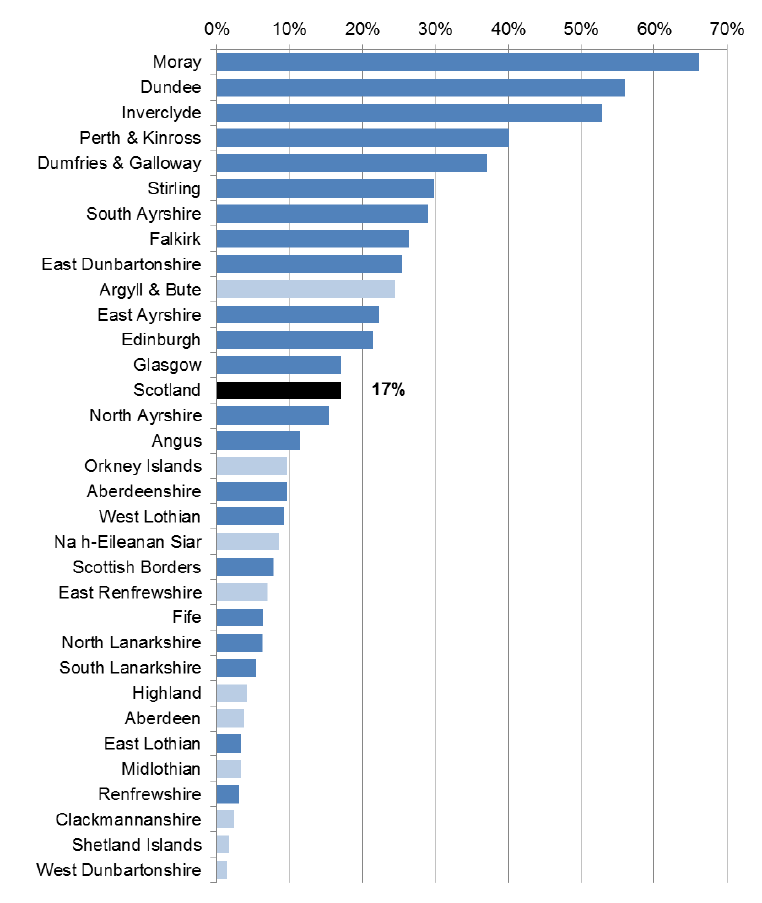Self-directed Support, Scotland, 2014-15
This ‘Data under Development’ Statistics Release presents the latest client and expenditure figures for Self-directed Support (SDS) in its first year of implementation (2014-15). SDS was introduced in Scotland on 1st April 2014 following the Social Care (
This document is part of a collection
2. Implementation of Self-directed Support
2.1 Implementation Rate
The 2015 Social Care Survey asked local authorities to return information on all clients who made a choice regarding their services or support at any time during the 2014-15 financial year. The key criterion for inclusion is the client having been given a choice - an individual should only be included if they have undergone an assessment during which the available SDS options were explained to them.
Under this definition, 35,173 clients were identified as having made a choice regarding their services or support during 2014-15. One measure of the national implementation rate for SDS is provided by the proportion that these clients represent of all social care clients present in the 2015 Social Care Survey. The Social Care Survey covers most, but not all, community-based social care services. On this basis, the 2014-15 implementation rate of SDS across Scotland would be estimated at 17%.
This figure provides an indicative value only and does not represent a target implementation rate. The scope of the Social Care Survey will vary across local authorities due to differences in population need and service provision. Not all clients on the Social Care Survey will be able to exercise choice over their services or support and this will impact the implementation rate that is ultimately obtainable by each local authority. It is expected that the SDS implementation rate will rise well above 17% in future, however the figure will not reach a complete 100%. Clients receiving reablement and / or crisis care support, for example, will not be able to make a choice regarding their services or support. Implementation rates at the local authority level, furthermore, will vary according to when the local authority started offering SDS and the speed of the phased roll-out that was deemed appropriate to that area.
With these issues in mind, Figure 1 (over page) shows that there were wide regional variations in the recorded implementation rate, with three local authorities recording figures over 50% and eight recording figures below 5%. Local authorities with known data recording issues (see Section 2.2) are highlighted in light blue. Given the incomplete SDS option data for these local authorities, it is not surprising that the majority of them show implementation rates that are below the Scottish average.
Figure 1: variations in SDS implementation rate by local authority, 2014-15

Local authorities shaded in light blue have incomplete SDS option data (see Section 2.2).
2.2 SDS Options Recording
Changes in data recording systems were necessary to capture SDS information in 2014-15, a process which takes time to complete. Consequently, not all local authorities were able to record information for the separate SDS options. In addition, some areas were still piloting SDS Option 2 during 2014-15 and will move to a full roll-out in subsequent years. Option 3, furthermore, is difficult for local authorities to record accurately as choosing this option during a review may mean that the individual concerned is carrying on with existing services and not all systems are currently able to report on this.
Within this context, all local authorities except East Renfrewshire were able to return SDS Option 1 information, reflecting the fact that data on Direct Payments has been collected since 2001. However:
- 20 local authorities [1] were able to return client information for all of the SDS options. A further two local authorities [2] returned information on those receiving Option 1 and Option 3 only, since they had no Option 2 clients.
- Nine local authorities were able to return information on clients who have chosen some, but not all, of the SDS options. Of these:
- Six local authorities [3] were able to return information on those receiving Option 1, but not those receiving Option 2 or Option 3;
- One local authority [4] was able to return information on those receiving Option 1 and Option 3, but not those receiving Option 2;
- Two local authorities [5] were able to return information on those receiving Option 1 and Option 2, but not those receiving Option 3.
- East Renfrewshire was not able to return any information on SDS option choices, although they were able to give the total number of clients who made a choice in 2014-15. This issue also affected 28% of clients in Orkney.
- Two local authorities [6] are known to have a limited number of pre-existing Direct Payment clients that are not included within their Option 1 client figures, as their systems record these two groups separately.
Taken collectively, such recording issues will mean that the observed total number of clients who made a choice regarding their services and support - and the national implementation rate - is an underestimate of the true position. Such issues will also contribute to the local variations in implementation rate discussed in Section 2.1. Many of the local authorities with below average implementation rates are those with known limitations to their recording systems (see Figure 1 above).
The 22 local authorities 3,4 with complete SDS option reporting account for 93% (32,665) of the previous client total. If the 2014-15 SDS implementation rate is estimated on the basis of these authorities only, then a value of 20% is obtained. This is considered to be the best available estimate for the national implementation rate, as it accounts for the known recording issues.
Contact
There is a problem
Thanks for your feedback